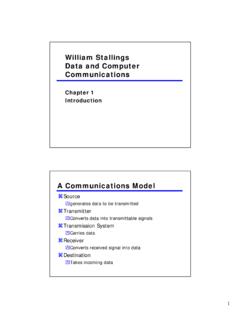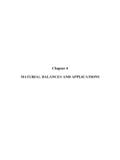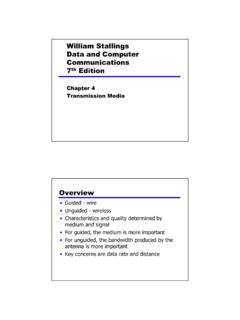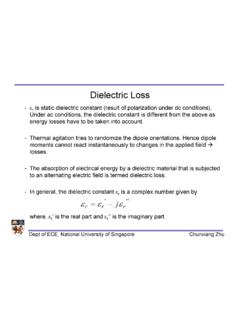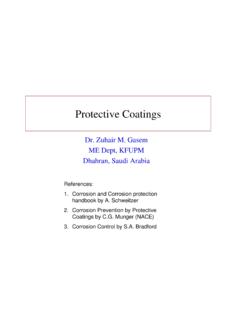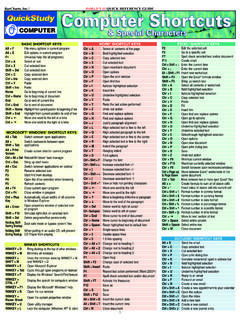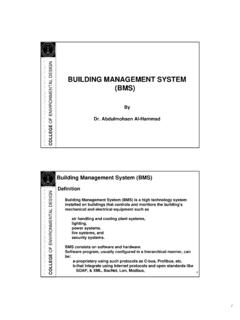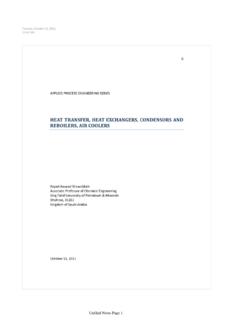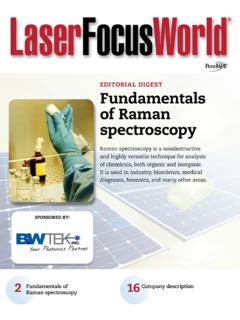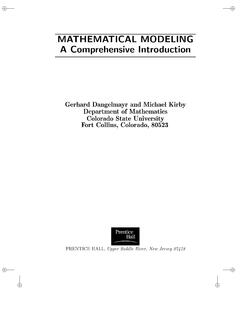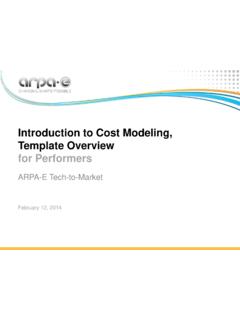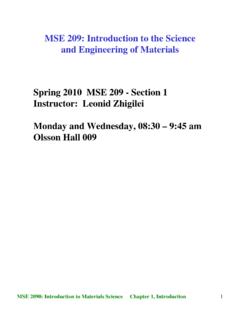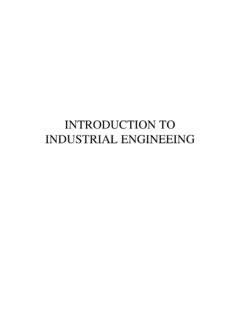Transcription of SE 207: Modeling and Simulation Lecture 1: Introduction
1 SE 207: Modeling and SimulationUnit 1 Introduction to Modeling and SimulationDr. Samir Al-AmerTerm 072 Unit Contents and ObjectivesRLesson 1: IntroductionRLesson 2: Classification of SystemsUnit 1 Objectives:RTo give an overview of the course ( Modeling & Simulation ). RDefine important terminologies RClassify systems/modelsSE 207: Modeling and SimulationUnit 1 Introduction to Modeling and SimulationLecture 1: IntroductionReading Assignment: Chapter 1 (Sections , )SystemsWhat is a system?SystemsRA systemis any set of interrelated components acting together to achieve a common covers systems of different typesQSystems vary in size, nature, function, complexity,..QBoundaries of the system is determined by the scope of the studyQCommon techniques can be used to treat themExamplesRBatteryRConsists of anode, cathode, acid and other components RThese components act together to achieve one objectiveRCar Electrical systemRConsists of a battery, a generator, lamps.
2 Rachieve a common objectiveRSAPTCO (transportation company)RConsists of Buses, drivers, stations,..RAchieves a common objectiveThe Boundaries of the system is determined by the scope of the studySystemsRAsystemis any set of interrelated components acting together to achieve a common system outputsSystemsRInputs (excitations):Qsignals that cause changes in the systems by arrows entering the systemROutputs (responses) :Qmeasured or calculated variablesQShown as arrows leaving the systemRSystems (process)QDefined the relationship between the inputs and outputsQRepresented by a rectangular boxThe choice of inputs/outputs/process depends on the purpose of the studyRSome Possible InputsQInlet flow rateQTemperature of entering materialQConcentration of entering materialRSome Possible OutputsQLevel in the tankQTemperature of material in tankQOutlet flow rateQConcentration of material in tankWhat inputs and outputs are needed when we want to model the temperature of the waterin the tank?
3 Modeling and SimulationModeling:Obtain a set of equations (mathematical model) that describes the behavior of the systemA model describes the mathematical relationship between inputs and outputsSimulation: Use the mathematical model to determine the response of the system in different Ball ExampleA ball falling from a height of 100 metersWe need to determine a mathematical model that describe the behavior of the falling of the model:answer these does the ball reach ground? is the impact speed?Different assumptions results in different modelsFalling Ball ExampleRCan you list some of the assumptions?QQQQQF alling Ball ExampleAssumptions for Model position = 100 x(0) = speed = 0 v(0) = : near sea only force acting on the ball is the gravitational force (no air resistance) )() ( )(:2 = =0)0(;100)0()(; :=== =vxtvdtdxdtdvModelFalling Ball ExampleSimulation of Model 1 The ball reaches ground at t = velocity = Ball ExampleMore modelsROther mathematical models are possible.
4 One such model includes the effect of air resistance. Here the drag force is assumed to be proportional to the square of the )0(;100)0()(; :2coeffient drag theis , resistanceair 22===+ ==vxtvdtdxvmcdtdvModelcwherecvHow far can this stunt driver jump?List some assumptions for solving this problemStunt driverRAssumptions:QPoint mass QMass of car+driver=MQInitial speed = v0 QAngle of inclination =aQNo drag forceQRModelcan be obtained to give the distance covered by the jump in terms of M,a, v0,..How do we obtain mathematical models? Modeling (Theoretical)RConstruct a simplified version using idealized elementsRWrite element lawsRWrite interaction lawsRCombine element laws and interaction laws to obtain the modelIdentification(Experimental)RConduc t an experimentRCollect dataRFit data to a modelRVerify the modelForce on the car driverRWhat is the force acting on the driver when the car moves over a rough surface?
5 RInput:the shape of the roadROutput:force acting on the driverRSystem model:describes the relation between input and output. Modeling Using Idealized ElementsRA simplified representation of the car by idealized elementsRSelect relevant variablesRWrite element lawsRWrite interaction lawsRObtain the modelWheel axelchassisseatdriverWhat is covered in this courseRModeling of SystemsQIdealized Elements (mechanical & electrical) QElement lawsQInteraction lawsQObtaining the modelRSolution of the ModelQAnalytic solution using Laplace transform QSimulation using SIMULINK SummaryRSystems: set of components, achieve common objectiveQInputs: signals affecting the systemQOutputs: measured or calculated variables QProcess: relating input and outputRModeling: Derive mathematical description of systemRSimulation.
6 Solving the mathematical modelRExamples of Modeling and simulationRTopics covered in the courseSE 207: Modeling and SimulationUnit 1 Introduction to Modeling and SimulationLecture 2: Classification of systemsReading Assignment: Chapter 1 Classification of SystemsRSystems can be classified based on different criteriaQSpatial characteristics: lumped & distributed QContinuity of the time variable:continuous & discrete-time & hybridQQuantization of dependent variable: Quantized & Non-quantized QParameter variation: time varying & fixed (time-invariant) QSuperposition principle: linear & nonlinearContinuity of time variablettt0 t1 t2 Continuous-time SignalThe signal is defined for all t in an interval [ti, tf]Discrete-time SignalThe signal is defined for a finite number of time points {t0, t1.}
7 }Give ExamplesRGive examples of Qcontinuous time signalRRRQD iscrete time signalRRRE xamples of signals ttt0 t1 t2 Temperature Sensor that provides Continuous reading of the temperaturetemperatureDigital Temperature Sensor that provides reading of the temperature every 30 SecondsClassification of SignalsContinuous-time,nonquantized(Anal og signal)Discrete-time,nonquantizedContinu ous-time,quantizedDiscrete-time,quantize d(Digital Signal)Classification of Signals and SystemsClassification of SignalsClassification of SystemsClassification of SystemsSystems are classified based on Spatial Characteristics (physical dimension,size) Continuity of time Linearity Time variation Quantization of variablesSpatial CharacteristicsLumped Models:Lumped models are obtained by ignoring the physical dimensions of the system.
8 A mass is replaced by its center of mass (a point of zero radius) The temperature of a room is measured at a finite number of points. Lumped models can be described by a finite set of state Models: Dimensions of the system is considered Can not be described by a finite set of state CharacteristicsLumped Models: Only one independent variable ( t ) No dependence on the spatial coordinates Modeled by ordinary differential equations Needs a finite number of state variablesDistributed Models: More than one independent variable Depends on on the spatial coordinates or some of them. Modeled by partial differential equations Needs an infinite number of state variablesQuestionsRGive examples of QDistributed modelsQLumped modelsContinuity of timeContinuous Systems:The input, the output and state variables are defined over a range of Systems:The input, the output and state variables are defined for t={t0,t1,t2.}
9 }. For other values of t, they are either undefined or they are of no Systems:Contains both continuous-time and discrete time subsystemsQuantization of the Dependant VariableQuantized variable: The variable is restricted to a finite or countable number of distinct valuesNon-Quantized variable: The variable can assume any value within a continuous of SignalsContinuous-time,nonquantized(Anal og signal)Discrete-time,nonquantizedDiscret e-time,quantized(Digital Signal)Continuous-time,quantizedQuestion sRGive examples of QContinuous signalQContinuous systemQDiscrete signalQDiscrete systemParameter VariationsSystems can be classified based on the properties of their parametersTime-Varying SystemsCharacteristics changes with time.
10 Some of the coefficients of the model change with timeTime-Invariant SystemsCharacteristics do not change with coefficients are constantsLinearityA system is linear if it satisfies the super positionprinciple. A system satisfies the superposition principle if the following conditions are satisfied:1. Multiplying the input by any constant, multiplies the output by the same The response to several inputs applied simultaneously is the sum of individual response to each input applied )()(3)()(2)(dt u(t) y(t)220tutytdttdytutty=+== u(t)y(t)Examples of Linear SystemsExamples of Nonlinear Systems)()()()()(2)(dt (t)u y(t)202tutytudttdytutty=+== LinearityExample of linear systems == =+=+=+==+===2020111212022012021202120222 011(t)dtu(t)dtuky(t)(t)uu(t)(t)y(t)ydt (t)u(t)dtu]dt (t)u(t)[udt u(t) y(t)(t)u(t)uu(t)dt (t)u (t)y,dt (t)u (t)ykkBoth conditionsare satisfiedu(t)y(t)LinearityExample of non-linear systems(t)y(t)y general (t)y(t)ut2(t)ut2u(t)u(t),(t)ut2 (t)y11111111 == = ==In(t)
